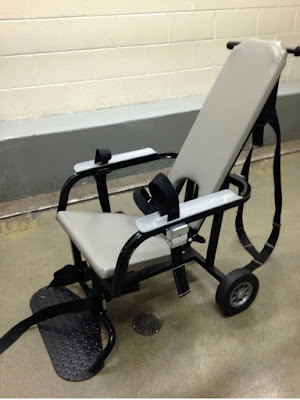Restraint Chair and Spit Hood
Blogger would not allow this to be pasted in a comment/reply...so I had to create a new blog post. This is the kind of chair that Natasha was restrained in on February 3.
Here is a spit hood. It has a mesh front to allow airflow, but when you are agitated, and overheating, I suspect it would feel "close" and make breathing more difficult.


This looks more like prison gear than treatment for those with mental illness.
ReplyDeleteI cannot even imagine how frightening and overwhelming this must have been for Natasha or anyone for that matter. Did her death prompt a change of response or new legislation?
ReplyDeleteI suspect not...
Sue, I googled and it looks like several more deaths by taser have occurred since this one. But "judges on a federal circuit court instructed police departments to treat Tasers similarly to the way they treat firearms — as deadly weapons that can't be used when someone is merely resisting arrest." But I guess Taser company was trying to appeal that.
DeleteI do know that federal guidelines have been anti-taser in mental health facilities for some time. And that Medicaid can refuse to reimburse for services to facilities that use them.
https://www.centralmaine.com/2013/08/20/tasers-handcuffs-cited-in-20-million-funding-cut-threat-for-riverview/
http://www.iimhl.com/files/docs/Make_It_So/20161020.pdf
If I remember correctly, Natasha had criminal charges as well as MI, which is not uncommon in our prison system. The materials that they used were definitely prison gear. It seems like the hood they used did not even have mesh all the way around.
ReplyDeleteThe rationale for utilizing 5 men in hazmat suits for one woman seems extreme, all of them using their full force to "subdue" her. I remember hearing statements like, "cooperate, we are your friends" and "stop resisting". Their behavior certainly does not instill a sense of safety.
After the death of Natasha McKenna, the Washington Post posted an article on April 13, 2015 and the Guardian posted an article on September 10, 2015 addressing the death of Ms. Mckenna. Both articles contradict one another the Washington Post states that Ms. Mckenna’s weight is 130 while five months later the Guardian states that deputies stated she weighed 181 1bs. Also, a medical examiner had previously ruled Ms. Mckenna’s death was due to “excited delirium” which cannot be found the DSM fifth edition. Could the reports from the sheriff’s department and the medical examiner be the beginning of a cover up that the Guardian wrote about on September 10, 2015. You can clearly see on the video Ms. McKenna did not weigh 181 lbs. and she did not growl with a demonic possession as the Guardian describes and inmate describing the scene as it unfolded. It should have never taken 5 men with contamination suits to secure Ms. Mckenna to place her on the constraint chair. This was clearly excessive force with knees to her back as she laid on her belly to the floor and should have never been used on Ms. McKenna. Additional factors involved in securing Ms. McKenna are the multiple taser shocks and the use of a “spit sock” are all aggressive measures that were used that accelerated the death of Ms. Mckenna. One key factor that the Sheriff’s correction facility should have keyed up on is that she had checked in to the Inova Springfield HealthPlex and told doctors that she had stopped taking her medications. If the mental health section at the correction facility would have done their job the correctional facility would not have let the correctional officers use the type of force that they administered and Ms. Mckenna would be alive today. These two articles depict that coverups in society still exist today and there needs to be more training in the industry of mental health throughout our nations correctional facilities.
ReplyDeleteJackman, T., (2015), The death of natasha mckenna in the Fairfax jail: the rest of the story.
https://www.washingtonpost.com/news/local/wp/2015/04/13/the-death-of-natasha-mckenna-in-the-fairfax-jail-the-rest-of-the-story/?noredirect=on&utm_term=.19d250becdf8
AP Fairfax, VA, (2015), Sheriff releases video of jail incident that led to Natasha Mckenna’s death.
https://www.theguardian.com/us-news/2015/sep/10/natasha-mckenna-jail-incident-death-virginia
Kupfer, D., Regier, D., Narrow, W., Schultz, S., (2013), DSM-5.
While many with SPMI are incarcerated, this should not be given as a license to abuse people or to not provide appropriate treatment.
DeleteNancy
Nancy,
DeleteWell stated, in the beginning of the video the Sheriffs representative was discussing what him and other representatives were going to do. From the time the steel gate was opened it seemed like the five men involved were working her over. At that point when they saw it would be impossible to control Ms. McKenna they should have put her back in her cell and thought about another course of action on how to take Ms. McKenna to her 1:00 pm appointment. Another thing I saw wrong is that there were two medical staff representatives (ladies) who connected the vitals monitor to her and they both said she is okay for transport after she had been tasered four times. Those medical representatives did not appear to be registered nurses better yet a the correctional doctor should have been summoned not the medical assistants. Nancy, your post brings it home on correctional facilities should not use abuse of power to transport a person for an appointment.
(no edit on here), meant the two ladies were connecting the vitals monitor to her and they both said she is okay to transport.
Delete